“Good golf begins with a good grip”
Did you know grip is one of the first things that golf teachers teach their students? More than 81% of golf teachers acknowledge this. The more exciting thing is that the golf grip is the only piece of equipment you touch on every shot throughout the game.
In this article, we will elaborate on how to hold a golf club with a proper golf grip. Then, you will get a step-by-step guide to achieve a proper golf grip. But first, let me tell you why the golf grip is so essential.
Butch Harmon answers this and says that the only connection with the golf club is the grip. So, if you get it wrong from the beginning, your dream of winning a future tour will remain a dream forever.
Without getting into Mumbo Jumbo, here’s what you will get to know from this article-
- How you can choose the proper grip style for you
- Learn to make a proper grip ideally step by step
- Avoid common mistakes that will hurt you later
- Learn the difference between strong and weak grip
- Pro tips to boost your golf skill from the beginning
Need a Shortcut for the Correct Golf Grip? Stay with us to find a unique tool at the end of this article. Let’s dive in!
Table of Content
How to Hold a Golf Club for Beginners (Step by Step Guide)
For right-handed players


Step 1: Get a tee peg
To hold your golf club properly, first get a tee peg. Place your right hand on the grip and your left hand above it.
Step 2: Wrap your fingers on the grip
In this step, wrap your right-hand fingers on the grip. It should feel like the club is placed on the fingers and not the palm. Do it in such a way that the left-hand fingers point towards your knees. Your right hand should remain on the side of your lead hand fingers.
Step 3: Place the tee peg between your fingers
Now place the tee peg between the crease of your thumb and the index finger of your right hand.
Step 4: Use both of your hands and place the tee peg straight towards the club
Make sure you are holding the club with both your trail and lead hands. If you do so, the tee peg should run straight towards the club. If you see that the tee peg goes towards either left or right of your club then fix that.
You are done! It’s that simple! This tee peg drill is very useful. It’s a drill that professionals teach beginners to get the grip right. It can help you ensure that you are doing perfectly.
How to hold a golf club left-handed
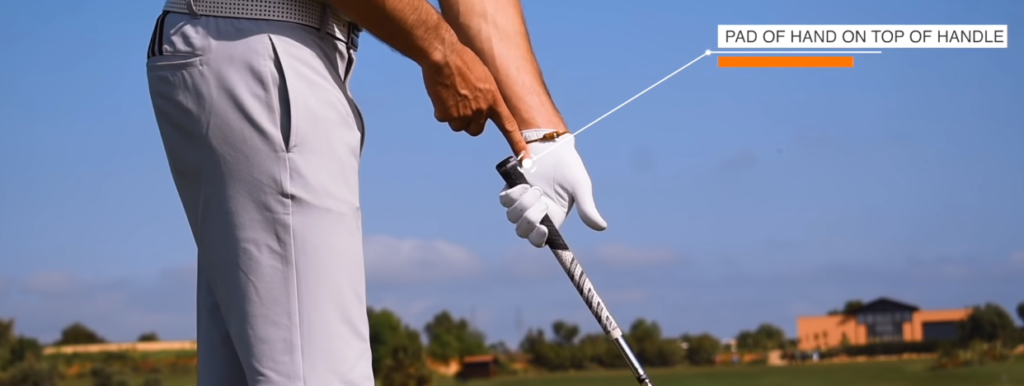
Step 1: Get a tee peg
At first, get a tee peg like before. Later it will help you again.
Step 2: Stand in front of a mirror
Try to stand in front of a mirror. If you do, you will have a better view of each step and it will ease your practice.
Step 3: Place the grip through the base of your fingers
Place the grip of the club through the base of your fingers on your left hand. The grip should run through the fingers diagonally.
Step 4: Wrap your fingers and put the pad on top of the club handle
When you get the previous step right, wrap your fingers around it. Now put the pad of your hand on the top of the club handle. The pad should feel like it is squashed on the top of the handle.
Step 5: Rest your thumb gently
Rest your thumb gently on the grip. With this grip position, you can easily rotate your hands to the right or left.
Step 6: Place the tee peg to straighten your grip
Now place the tee peg in the same position as I mentioned earlier but now in your left hand. If you can get the tee peg run straight down the club, that should be your ideal way of holding the club.

2 common faults beginners make
- When you hold the club in your left hand, the fingers point towards the ground.
- When you grip the club, you can see a gap between your little finger and the club. The pad is more underneath rather than squashing on the handle.
Pro-tip for left-hand grip
When you wrap your fingers around the club, an important thing you must notice. The upper part of your left-hand thumb should fit right into the middle of the two right-hand pads. More precisely, just below the top pad.
If you follow this pro tip, you should have complete control of the club and your hands- the club will work as one unit. So, the club will slip less in your hands when you are making a swing. If you are placing your palm too much underneath the golf club, you are doing it wrong.
3 Most Popular Golf Grip Styles
The most important thing that every golf enthusiast wants to know while learning their grip is- “how do you connect the hands together? What are the grip styles?”
So let’s get introduced to three styles that pros follow.
- Vardon Overlap
- Interlocking
- Baseball
1. Vardon Overlap grip
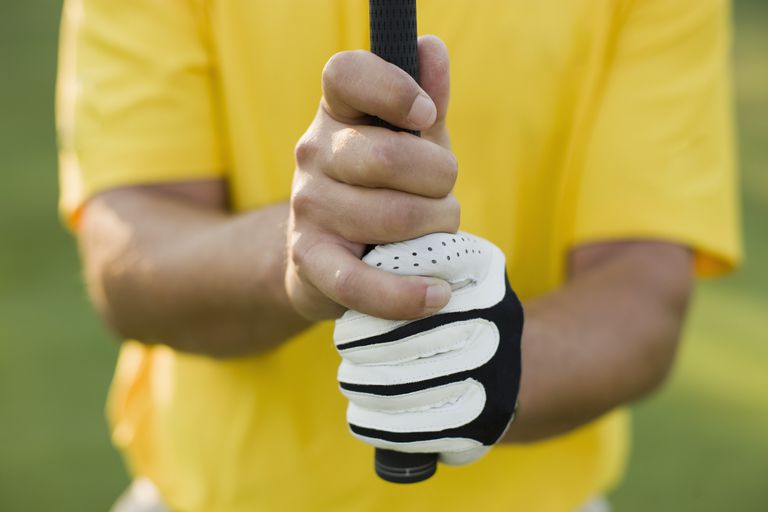
The most traditional and popular golf grip style is the overlap grip (say just “overlap” if you want to sound like a pro). This grip looks easy but hard to adapt. In most cases, male golfers tend to use the overlap grip. Many female golfers also prefer this grip.
Who should use the overlap grip style?
Those who have larger hands and longer fingers should use the overlap grip style. Otherwise, skip it. Most tour players and a majority number of amateur golfers use this grip. So if you are a professional or amateur golfer with larger hands, you should use an overlap grip style.
How to hold an overlap grip?
Just place the little finger of your trail hand in the ridge between the index and middle finger of your lead hand. Your lead hand thumb should adjust with the lifeline of your trail hand. Thus both hands will be connected through the right pinky finger. Remember, it’s called overlap because the little finger overlaps the index finger.
2. Interlocking grip
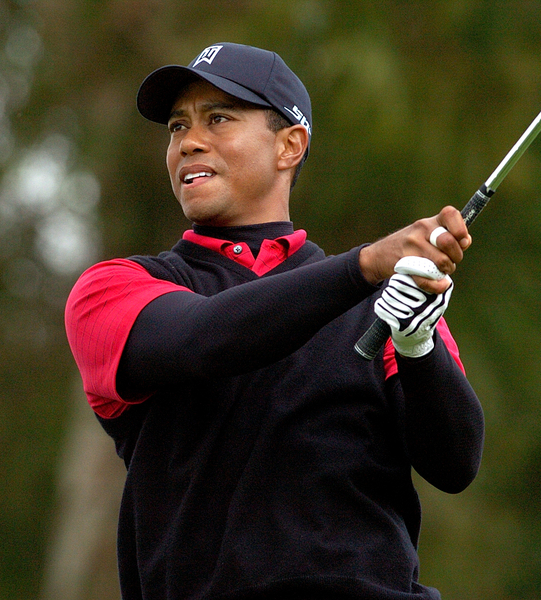
You must have known that the legendary golfer Tiger Woods used to play with an interlocking grip. A slight variation from the overlap grip will give you an interlocking grip. The name itself describes the procedure. For better control and to get the feel of your hands and club working together, the interlock is the best choice.
Who should use the interlocking grip style?
Those who have medium-size hands find this style comfortable. Female golfers are especially comfortable with the interlocking grip. However, it’s not suitable for large or small hands. Golfers who want to cover shorter distances should use interlocking grip style. But if you focus on full shots, you should better skip this one and choose another grip style.
How to hold an interlocking grip?
Interlock your hands by putting your non-dominant hand index finger in between the pinky of your dominant hand. In other words, just place the little finger underneath the index finger, making a cross-link. But don’t make the interlocking too tight. Keep it moderately loose.
3. Baseball grip or ten-finger grip
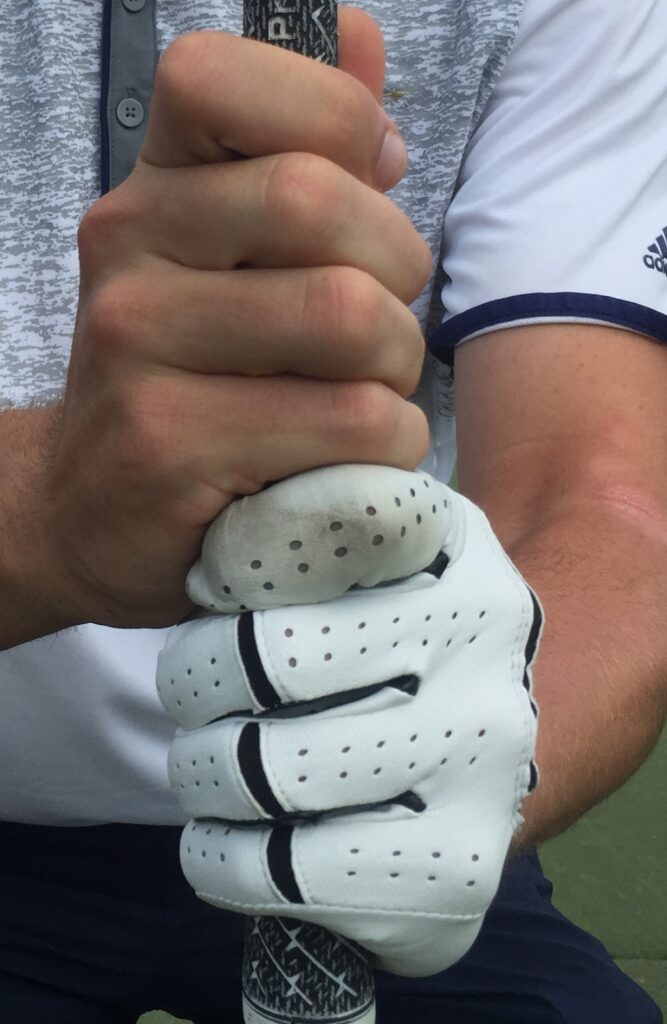
The grip is reasonably straightforward. No gaps should be there; no locking or lapping is needed. Just all your fingers will touch the club. This is the easiest of all grip styles but you may not play as accurate long shots as you can with Interlocking or Overlapping style. It’s also known as ’10 finger grip’ and ‘neutral grip’.
Who should use the baseball grip?
This grip style is suitable for players with small hands and low swing speed. Especially for children, younger golfers, and women. If you have larger hands, skip it. As it’s very effortless to use, beginner golfers like this grip most.
How to hold a baseball grip?
In this grip, all the fingers of both your lead and trail hand will be in contact with the golf club. You should line up the little finger of the trail hand and the index finger of your lead hand.
Strong Grip vs. Weak Grip vs Neutral Grip
Many players have succeeded with a strong grip, weak grip, or neutral grip. In this guide, I have insisted on using a neutral grip. Yet you can experiment on all of them to know what grip will suit you most.
But before knowing about what grip you should try, you need to have a clear conception of those grips. Here are three golf grips pro golfers follow – Strong, weak, and neutral grips.
What is a Strong Golf Grip?
When a ‘V’ shape is created with your thumbs and your hands pointing towards the right side of your head, then this position is considered as a strong grip. A strong grip can help you fix a slice and help you make a way out if you swing over the top.
In a strong grip, your rotated hands remain away from the target. And while having a strong grip, golfers are suggested to keep their hands quiet instead of active. Because it gives a more consistent result. Maximum renowned golfers including Tiger Woods used to take strong grips. Even the great women golfers like Patty Berg were famous for their exceedingly strong grip.
How to hold a strong golf grip

For a strong grip, place your golf club in the same position and notice where the V’s are pointing. If the V’s point towards your right, then you are having a strong grip.
Pro tip: Strong or weak grip might cause a curve on the ball as you hit it. So, stick with the neutral grip before you develop a deeper understanding of the ball’s position.
What is a Weak Golf Grip?
When the ‘V’ shape remains towards the left of your head, it’s called a weak grip. If you want to get rid of hook shots, you need a weak grip. It will help your clubface move slowly through impact and allow your club to create more out-to-in swing.
In a weak grip, your rotated hands remain close to the target. It will drive you to flip your hands towards impact and square the face. Here active hands are more effective than quiet ones. Ben Hogan, the great golf legend used to have a weak grip throughout his career. [Source]
How to hold a weak golf grip

When you place your golf club in front of you and see that the V’s are more to your left, then it’s a weak grip.
Pro tip: Don’t keep your hands in a very restricted position. Making a fully rolling impact on the ball will be hard.
What is a Neutral Golf Grip?
If the V shape made in your thumbs remains towards your nose, it indicates itself as a neutral grip. A neutral grip is neither on the right side of your head nor on the left. It remains somewhere between these two. And that ‘somewhere’ points towards your nose.
Once you learn the proper technique of shaping the ball, a neutral grip is what can help you most. It’s recommended for the golfers having medium hip speed.
How to hold a neutral golf grip?
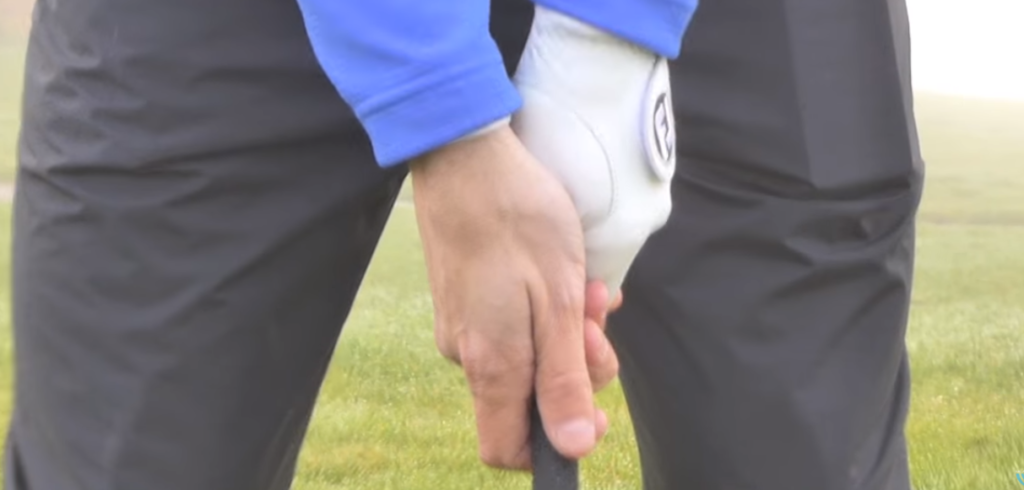
First, focus on the V’s of your hands.
If the V’s of your lead hand run straight towards you and the trail hand is slight to the right, then it is a neutral golf grip.
If you are still confused about whether it’s a neutral grip or not, then do the following experiment.

Hold the club horizontally and observe the back of your hand.
If you see that the clubface is parallel with the back of your hand, then it’s a neutral grip.
Shortcut for Golf Grip
Here comes the shortcut that I mentioned at the very beginning of the article. It can boost your golf learning process, as I believe.

It’s Golf Training Aid, a unique tool that you can use on any golf club you have. This tool comes in pocket size and will help you achieve the perfect grip every time.
PGA professionals have developed this tool. It will help you build muscle memory that can give you consistent results. Raise the standard of your game if you want to become a pro.
Conclusion
What would happen if you don’t know how to hold the steering or control it while driving? I think we both know the answer to that question. Like steering the only media to direct your vehicle in an accurate direction, the golf club plays the same role in golf. The club is the only connection to play your ball in an accurate direction.
So, if you don’t know how to grip a golf club, you will fail to master accurate shots. Nevertheless, your inaccurate shots will eventually result in defeat in competitive games. On the other hand, when you are comfortable with your grip over your club, you will play strokes a lot easier and more comfortably.
Hope you can practice and adapt any of the methods mentioned above to master its playing. Let us know how you are doing.

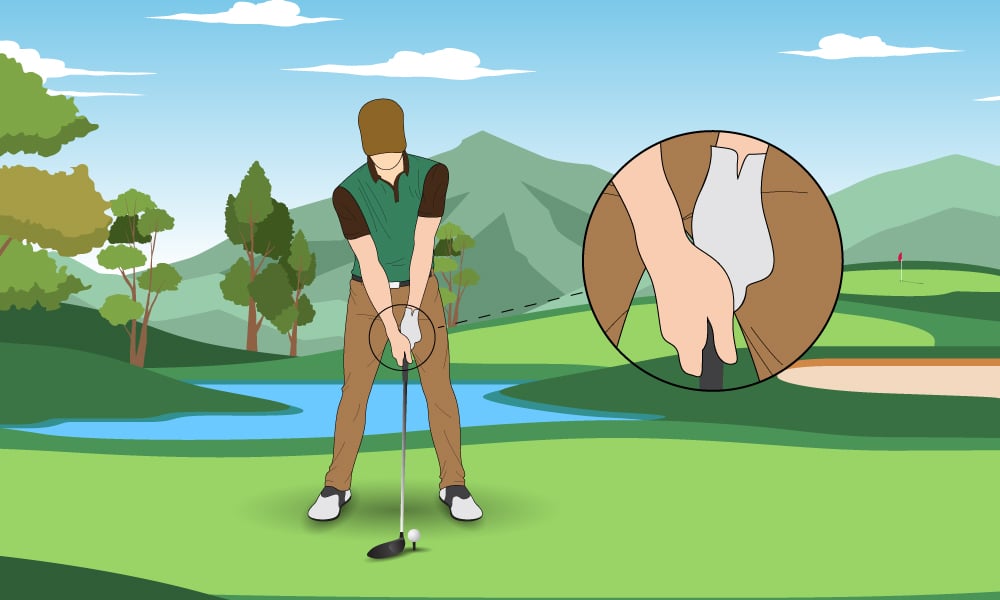
that is great to see as I just started learning to play golf.